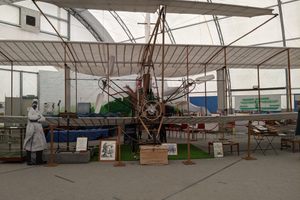
On the 16th of October, 1908, Samuel F Cody, in his British Army Aeroplane No.1, made the first powered, manned, and sustained flight in the United Kingdom.
Samuel Cody was an American Wild West showman who, having developed an interest in flight, settled in Farnborough, which was already a center for aviation development. Here, Cody designed and built a flying machine, using materials from the Farnborough Balloon Factory. In 1907, Cody began constructing a powered aircraft of a similar configuration to that used by the Wright brothers, expanding the wingspan to 52 feet, and the following year he was ready to make history.
In the United Kingdom's first powered and sustained flight, Cody covered 1,390 feet. His flight had an abrupt landing after one wingtip collided with the ground while the first-time pilot tried to avoid a group of trees. After spending the rest of the year on repairs, Cody made further flights in early 1909. Now able to remain airborne for several miles, Cody considered his plane safe enough to take a passenger. He took his wife, making Lela Cody the first woman to fly in an aeroplane in the United Kingdom.
Less than half a kilometer from the take-off point of Cody’s historic flight, and overlooking Farnbough’s Airport, the Farnborough Air Sciences Trust (FAST) museum houses a full-size replica of British Army Aeroplane No. 1. Built in preparation for the 100th anniversary of the UK’s first flight in 2008, the replica was created by a team of volunteers using materials authentic to Cody's first aeroplane. Now displayed within the museum’s Cody Pavillion, aviation and history enthusiasts alike can visit and admire this iconic plane.
Less than five years after his first flight, Samuel Cody died. He had designed five more planes in the same number of years, and was piloting his newest design in 1913 when it broke up at 200 feet over Farnborough. Despite being a civilian, Cody was buried at Aldershot’s Military Cemetery with full military honors, in recognition of his immense contribution to aviation in the British Armed Forces.
Also within the FAST museum, you can find a Flying Cap of Cody’s, which he used to provide limited protection during crashes ‘or enthusiastic landings’, alongside a vast collection of artifacts from Farnborough’s long history in aviation.
Outside the museum stands a statue of Samuel F Cody, and 300 meters away, beside the Aviator Hotel, a plaque and stone mark the site where he first took off on the UK’s first flight.

Post a Comment